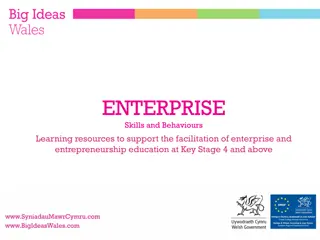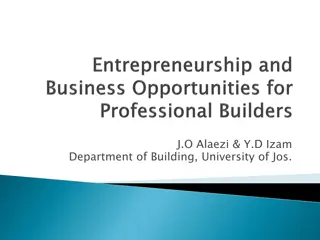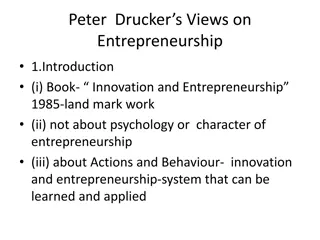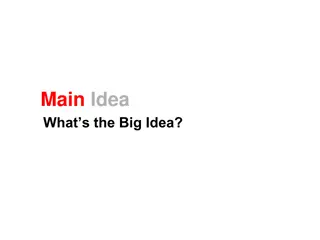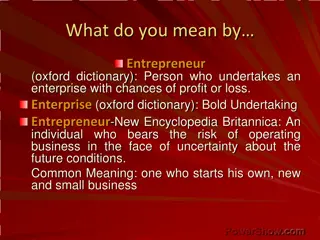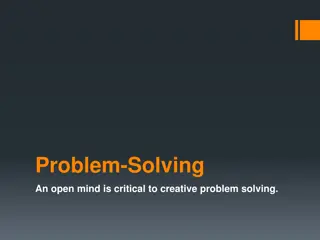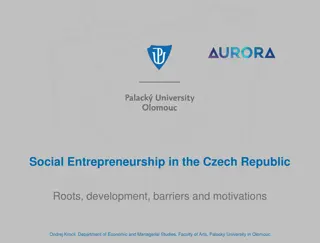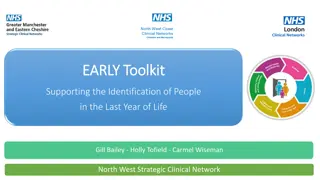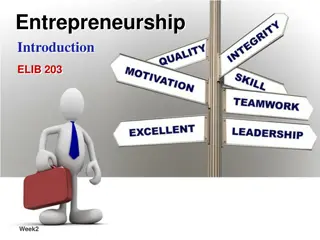Entrepreneurship Scholars Idea Building Toolkit for Problem-Solving
This toolkit is designed for Entrepreneurship Scholars applicants to develop innovative solutions to wicked problems like urban poverty, climate change, and more. It includes rules of the challenge, design thinking exercises, and resources to help build a compelling pitch for a chance to win up to $5,000 towards their entrepreneurial endeavor at Lycoming. From understanding the problem to individual brainstorming, this toolkit guides aspiring entrepreneurs through the creative process.
Download Presentation

Please find below an Image/Link to download the presentation.
The content on the website is provided AS IS for your information and personal use only. It may not be sold, licensed, or shared on other websites without obtaining consent from the author.If you encounter any issues during the download, it is possible that the publisher has removed the file from their server.
You are allowed to download the files provided on this website for personal or commercial use, subject to the condition that they are used lawfully. All files are the property of their respective owners.
The content on the website is provided AS IS for your information and personal use only. It may not be sold, licensed, or shared on other websites without obtaining consent from the author.
E N D
Presentation Transcript
IDEA-BUILDING TOOLKIT FOR ENTREPRENEURSHIP SCHOLARS FOR ENTREPRENEURSHIP SCHOLARS APPLICANTS APPLICANTS
WELCOME! THIS TOOLKIT CONTAINS Rules of the challenge Design thinking information to help you come up with a solution to your problem Reference material to help you build your pitch
RULES ENTREPRENEURSHIP SCHOLARS PITCH To compete for a spot as a Lycoming Entrepreneurship Scholar, you must create a Rocket Pitch (3 slides, 3 minutes) for a business idea to tackle a wicked problem. The best presentations could win up to $5,000 towards a start-up or other entrepreneurial experience during your sophomore, junior, or senior year at Lycoming. A wicked problem is: a complex social problem with no obvious solutions and competing viewpoints as to how best to go about solving it. You will choose between these wicked problems: Urban poverty Climate change The rising cost of medical care Lack of access to clean water Low U.S. rankings in quality of education
RULES (cont.) ENTREPRENEURSHIP SCHOLARS PITCH Follow the Pitch Deck Template to create your presentation and come prepared to deliver it in three minutes Bring your PowerPoint with you to Scholars Day on a flash drive, and print a copy of your slides for the judges
FINDING YOUR IDEA HOW DOES ONE COME UP WITH A WAY TO SAVE THE WORLD? One method used by many entrepreneurs is called design thinking, which involves generating and testing ideas to decide which ones are likely to work. Design thinking is all about generating lots of ideas, turning piles of ideas into a few good ideas, and then testing those good ideas to see if they actually work. You ll need to invest some time in the process!
DESIGN THINKING EXERCISE: UNDERSTANDING THE PROBLEM INSTRUCTION: Once you have selected your problem, you should familiarize yourself with the problem. Don t develop any biases about what a solution must look like, but try to thoroughly understand the causes and effects surrounding the problem. Find information from . Credible news outlets Activist groups that deal directly with the problem Think tanks and research institutes Scholars who study your problem Books Your teachers may be able to direct you to good sources
DESIGN THINKING EXERCISE: INDIVIDUAL BRAINSTORMING INSTRUCTION: Once you have selected your problem, you should use the prompts below to individually write 3-7 sticky notes with insights answering each prompt. No idea is too crazy! Prompt #1 Who are the groups that are impacted by this problem and how large are those groups? What happens that affects these groups? Can these effects be reversed and how? Can they be limited and how? What other similar problems have been solved before that you can look to for inspiration? Are there tools and/or technology available that could help? What are the root causes of this problem and can we tackle them? Why would we want to solve the problem?
DESIGN THINKING EXERCISE: BUILD ON IDEAS INSTRUCTION: One by one, post your sticky notes on a wall and review them. If you would like to add to the pile at this point, go ahead. Do not eliminate any ideas you ve posted as implausible we re not there yet. Besides, thinking inside the box hasn t helped anyone solve these problems yet!
DESIGN THINKING EXERCISE: SORT IDEAS INSTRUCTION: Sort your ideas based on shared characteristics. You will likely come up with some ideas that are similar or related this step lets you consider fewer individual ideas and hone in on the top contenders.
DESIGN THINKING EXERCISE: SELECTING IDEAS INSTRUCTION: Grab a marker and put an X on the sticky next to the 3 ideas you think would best inform a plan to tackle a piece of your wicked problem. This process highlights which idea you want to develop into a concept in the next step.
PUT YOUR IDEA TO THE TEST INSTRUCTION: Ideas that don t hold up under scrutiny will be unlikely to truly solve the problem. Vet your ideas by thinking critically and asking others for their input. 1. 1. Start with the people at hand Start with the people at hand Share your idea with your parents, neighbors, friends, etc., anyone who can challenge you to prove it makes sense. Talk to a teacher or outside expert Talk to a teacher or outside expert People who have training in how to understand problems can provide unique perspectives on your ideas. Teachers and local leaders who are willing to help can be great assets. Ask someone affected Ask someone affected No one knows a problem better than someone who has lived through it. If you know anyone who has been affected by your problem, ask them what they think of your idea. 2. 2. 3. 3.
SYNTHESIZE, CREATE, & PREPARE TO PITCH INSTRUCTION: Next, you should select, refine, and submit a single business concept for judging by following the steps below. 1. 1. Synthesize your best insights into one actionable idea. Synthesize your best insights into one actionable idea. Frame it in the Pitch Deck Template in terms of the problem, your solution, and what you need. Use the Business Model Canvas Use the Business Model Canvas Understand how the organization will operate Identify who can help you Assess the sustainability of the company Create or find an image/caption that captures the idea for your title slide Create or find an image/caption that captures the idea for your title slide 2. 2. 3. 3.
ADDITIONAL HELP DESIGN THINKING RESOURCES: https://www.ideou.com/pages/brainstorming EMPATHIZE https://hbr.org/2014/03/the-future-of-prototyping-is-now-live DEFINE https://www.fastcompany.com/3045148/8-habits-of-curious-people https://www.ted.com/talks/tim_brown_urges_designers_to_think_big https://designthinkingforeducators.com/ IDEATE https://dschool.stanford.edu/resources/design-thinking-bootleg PROTOTYPE https://www.edutopia.org/blog/film-festival-design-thinking-in- schools TEST
PITCH-MAKING RESOURCES FOR YOUR SCHOLARS DAY PRESENTATION https://www.entrepreneur.com/article/251311 https://www.entrepreneur.com/video/337050 https://articles.bplans.com/9-things-that-take-a- pitch-from-good-to-great/ https://www.entrepreneur.com/article/316786 Watch this (and the other episodes of Entrepreneur Elevator Pitch ) to see a great example of how quick pitches can be effective.




